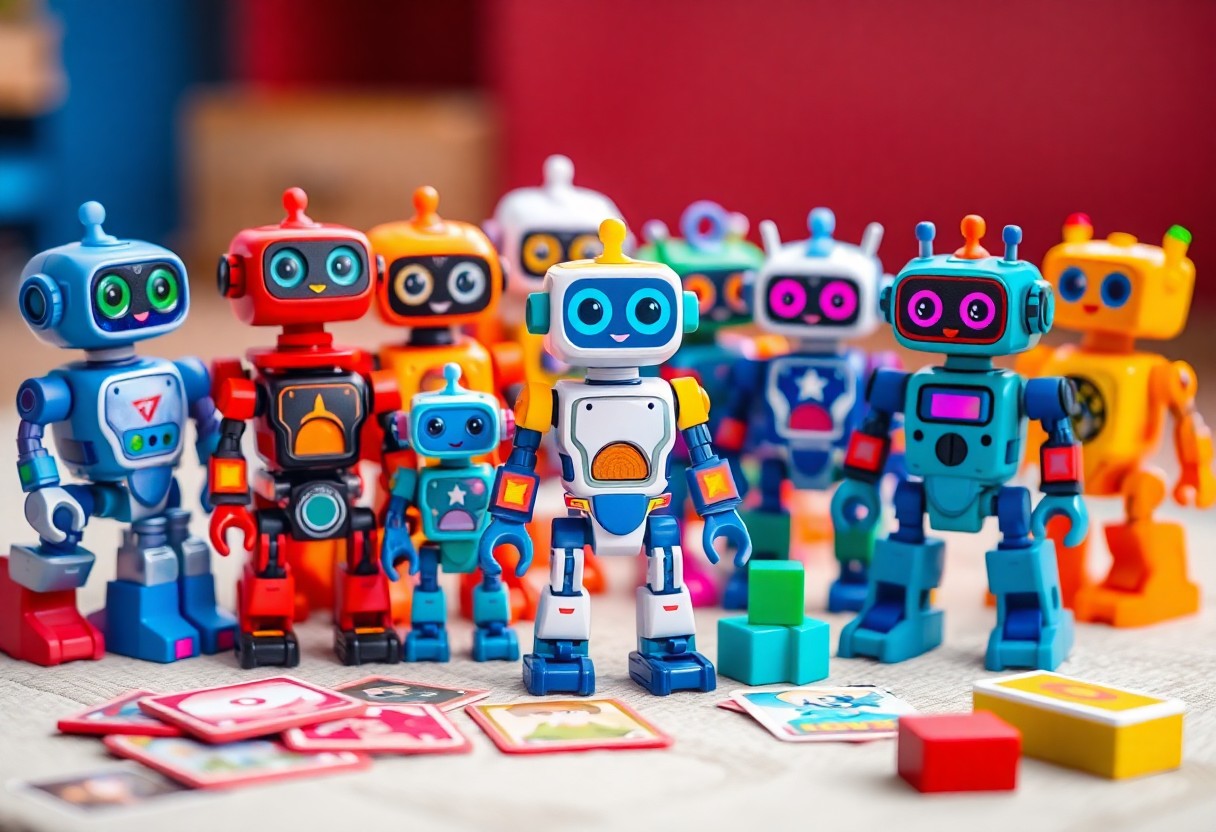Education can be exciting, especially when it involves interactive tools like educational toy robots. These engaging devices not only spark creativity but also enhance learning in various subjects, from coding to problem-solving. In this guide, you will discover the top five educational toy robots that will captivate your child’s interest and make learning an enjoyable experience. Whether your child is a budding engineer or a curious explorer, these robots offer a perfect blend of fun and education, ensuring a bright future for your little one.
Types of Educational Toy Robots
Before venturing into your options, it’s vital to understand the different types of educational toy robots available. Each type has unique features, catering to various learning objectives.
| Type | Description |
| Coding Robots | Teach the basics of programming and logic. |
| STEM-Focused Robots | Emphasize science, technology, engineering, and mathematics. |
| Building Robots | Encourage creativity through assembly and design. |
| Companion Robots | Provide interactive learning experiences. |
| programmable Robots | Allow for custom missions and tasks. |
Perceiving the variety of options helps you choose the right robot that aligns with your child’s interests and educational needs.
Coding Robots
An exciting way to introduce your child to computing concepts is through coding robots. These playful devices allow you to engage your child in writing simple commands and algorithms. With visually appealing interfaces designed for young learners, coding robots make problem-solving enjoyable, turning the learning process into a game that captivates their attention.
STEM-Focused Robots
Robots that concentrate on STEM education bring fascinating hands-on experiences to your young learners. These robots empower you to explore various scientific principles, engage in engineering challenges, and solve mathematical puzzles. By integrating practical projects and theoretical knowledge, your child gains valuable skills that provide a solid foundation for future pursuits in STEM fields.
Plus, STEM-focused robots promote critical thinking and collaboration, as kids often work in teams to create and experiment. In addition, they can spark an interest in technology and innovation, making it easier for your child to adapt to a world increasingly influenced by science and engineering. Through these interactive experiences, you are igniting the passion for learning in your child.
Factors to Consider When Choosing
You want to ensure the educational toy robot you choose for your child is the best fit for their learning experience. Consider the following factors:
- Age suitability
- Complexity of the programming
- Target skills and learning objectives
- Durability and safety features
- Interactive and engaging design
Recognizing these factors will help you select a toy that not only educates but also entertains, making learning an enjoyable journey.
Age Appropriateness
Little ones grasp concepts differently at various ages, so it’s necessary to choose toys designed for their developmental stage. While some robots are tailored for toddlers with simple functions, others may challenge older kids with advanced coding tasks. Selecting age-appropriate toys ensures that your child remains engaged and avoids frustration while learning.
Skill Development Opportunities
There’s a wide range of skills that educational toy robots can help develop, from coding and problem-solving to creativity and critical thinking. These robots often provide interactive challenges that can spark interest in STEM subjects and encourage collaborative play.
It’s important to select toy robots that align with the valuable skills you want your child to learn. For instance, some robots may focus on programming languages, while others emphasize teamwork through group activities. By choosing the right robot, you empower your child to explore various skills, fostering their growth in a fun and engaging manner.
Tips for Maximizing Learning
Assuming you want to enhance your child’s learning experience with educational toy robots, consider the following strategies:
- Set aside dedicated playtime for exploration.
- Encourage problem-solving by introducing challenges.
- Incorporate reviews of concepts during play.
- Use the robots to relate learning to real-world scenarios.
- Engage your child in discussions about what they learned.
Knowing these tips will help you create a more enriching environment for your child’s educational journey.
Integrating Play with Education
An effective way to enhance your child’s learning is by integrating play with education. Using educational robots, you can create engaging scenarios that allow your child to explore concepts while having fun. For instance, you can set up experiments that require programming the robot to solve puzzles, effectively merging creativity with critical thinking. This approach motivates your child to innovate and can help reinforce the lessons they’ve learned in school.
Encouraging Collaborative Learning
Encouraging your child to collaborate with peers can significantly enhance their learning experience. By working together on projects involving educational toy robots, children can share ideas, solve problems, and learn from each other. This interaction promotes communication skills and fosters teamwork, both of which are important for lifelong learning. You can set up small challenges for a group of children, providing a platform for them to brainstorm and find solutions collectively.
Integrating collaborative learning also encourages diverse perspectives, which can enhance creativity and critical thinking. When children tackle challenges together using educational robots, they learn to value each other’s inputs, leading to a richer understanding of the subject matter. You can facilitate discussions, allowing each child to contribute their thoughts and strategies, ultimately enriching their learning experience while making it enjoyable. This social interaction not only reinforces educational concepts but promotes important soft skills that your child will use throughout their lifetime.
Step-by-Step Guide to Engaging with Toy Robots
Now that you have chosen a toy robot, it’s time to examine engaging with it! This guide will help you make the most out of your interactions, ensuring both fun and educational value.
Engagement Steps
| 1. Set Clear Goals | Define what you want to achieve with your robot, such as learning programming or enhancing problem-solving skills. |
| 2. Choose Appropriate Activities | Select activities that align with your goals while also considering your child’s interests. |
| 3. Foster Collaboration | Encourage group play, allowing kids to work together and share ideas. |
| 4. Reflect on Experiences | After activities, discuss what was learned and how they can improve next time. |
| 5. Mix It Up | Continuously introduce new challenges and concepts to keep the learning experience fresh. |
Planning Activities
Now it’s time to plan exciting activities that will keep your child engaged with the robot. Craft a diverse range of tasks that cater to various learning styles, from coding challenges to creative storytelling. It’s beneficial to periodically rotate activities to maintain enthusiasm and encourage new learning experiences.
Tracking Progress and Learning
Guide your child’s learning journey by tracking progress effectively. Regular assessments can help you understand which skills have been mastered and where additional focus may be needed.
Plus, keeping a record of your child’s successes can motivate them to tackle more complex challenges. You might create a chart to visually show their improvements or jot down notes after each session. This way, you can tailor future activities to reinforce their strengths and address any areas needing more attention, promoting continuous growth in their learning journey.
Pros and Cons of Educational Toy Robots
Despite their increasing popularity, educational toy robots come with both benefits and drawbacks that you should consider before purchasing. Understanding these aspects will help you decide if such toys are the right fit for your family.
Pros and Cons
| Pros | Cons |
| Encourages STEM learning | Can be expensive |
| Enhances problem-solving skills | Requires adult supervision |
| Promotes creativity | Limited battery life |
| Interactive and engaging | May require updates |
| Improves fine motor skills | Complexity may frustrate some kids |
Advantages of Using Toy Robots
Some of the key advantages of using toy robots include fostering creativity and critical thinking, while also promoting interest in technology. Engaging with these robots allows your child to explore predefined coding concepts and build problem-solving skills, making learning enjoyable and interactive.
Potential Drawbacks
If you are considering educational toy robots, it’s important to be aware of some potential drawbacks. These toys can sometimes frustrate children who struggle with complexity or require consistent adult supervision to maximize their benefits.
Potential limitations of educational toy robots include the initial investment costs, which can be high depending on the features you choose. Additionally, some models may require ongoing updates or repairs, and battery life can be a concern. These factors could lead to a higher maintenance effort on your part, making it vital to carefully evaluate your options before purchasing.
The Top 5 Educational Toy Robots
For parents seeking innovative ways to make learning enjoyable for their children, educational toy robots are a fantastic solution. These interactive devices blend technology with play, allowing your child to explore coding, electronics, and problem-solving in a fun and engaging manner. In this section, we’ll introduce you to five exceptional educational toy robots, each designed to inspire curiosity and foster a love for learning in young minds.
Overview of Each Robot
The selected educational toy robots offer a range of engaging activities tailored for various age groups. From coding challenges to STEM-based tasks, these robots provide hands-on experiences that facilitate learning while ensuring that your child remains entertained. Each robot showcases unique attributes suited to different learning styles and interests.
Key Features and Benefits
While choosing the right educational robot, it is crucial to consider their key features and benefits, ensuring they align with your child’s learning objectives. These robots not only make learning enjoyable but also promote creativity and critical thinking. Here’s what you can expect:
- Interactive programming opportunities that enhance coding skills.
- Hands-on activities that improve fine motor skills.
- Engagement through games and challenges that inspire teamwork.
- Customizable experiences that cater to various skill levels.
- Educational content that covers various subjects, including math and science.
After exploring these features, you’ll see how these robots can significantly contribute to your child’s educational journey.
Understanding Key Features and Benefits
Understanding the key features and benefits of educational toy robots helps you choose the ideal match for your child. While each robot has its unique attributes, they all share the common goal of making learning a delight. Look for robots that offer a balance of educational value and fun:
- Versatile learning modes promoting different skills and subjects.
- Robust community support for additional resources and ideas.
- Intuitive design that makes it easy for kids to interact and learn.
- Durable construction ensuring long-lasting play.
- Regular updates and expansions that maintain engagement over time.
After assessing these features, you’ll be better equipped to find a robot that ignites your child’s enthusiasm for learning.
Conclusion
As a reminder, choosing the right educational toy robot can significantly enhance your child’s learning experience while making it enjoyable. The top five robots highlighted not only engage your child’s creativity and problem-solving skills but also provide a hands-on approach to STEM education. By incorporating these innovative toys into playtime, you empower your child to explore complex concepts in a fun and interactive way, ultimately fostering a lifelong love for learning.







